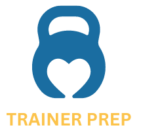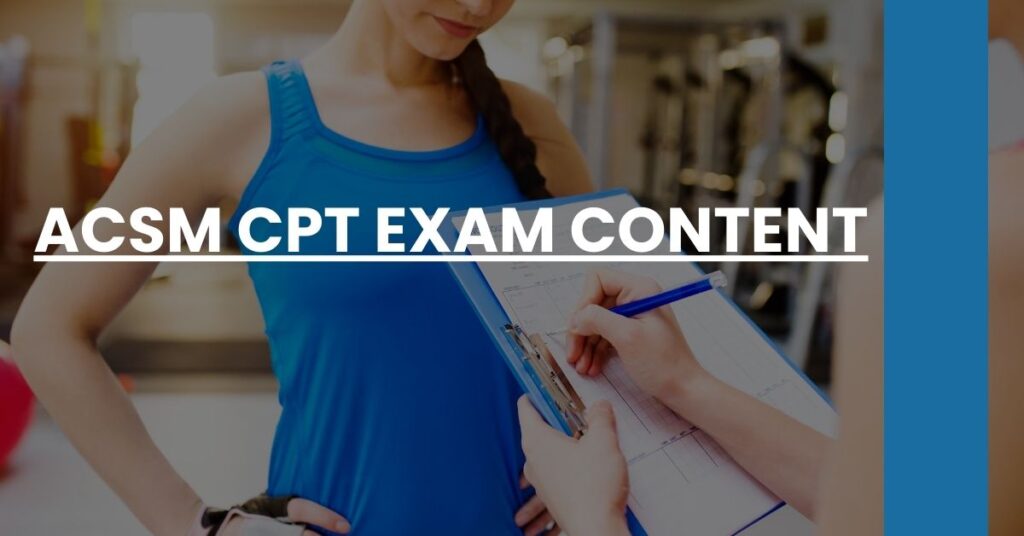Understanding the ACSM CPT exam content is crucial for aspiring certified personal trainers. The exam covers four key domains:
- Initial Client Consultation and Assessment (25%)
- Exercise Programming and Implementation (45%)
- Exercise Leadership and Client Education (20%)
- Legal and Professional Responsibilities (10%)
It consists of 150 multiple-choice questions.
In this article, you’ll learn the details of each domain, effective study strategies, and what to expect on the exam day.
Introduction to the ACSM CPT Exam
The American College of Sports Medicine (ACSM) Certified Personal Trainer (CPT) exam is a must for fitness professionals aiming to advance their careers. It certifies your ability to work with various clients, designing effective fitness programs to achieve their health and wellness goals. As the fitness industry’s gold standard, the ACSM CPT certification sets you apart, emphasizing your commitment to excellence and professionalism.
Importance of the ACSM CPT Certification
Earning the ACSM CPT credential signals your expertise in exercise science, client assessment, program development, and professional responsibility. Not only does it elevate your professional standing, but it also opens doors to various career opportunities such as working in health clubs, wellness centers, or even running your own personal training business.
Exam Structure and Format
Understanding the structure and format of the ACSM CPT exam is crucial for success.
The exam consists of 150 multiple-choice questions. Of these, 120 are scored, and 30 are unscored pilot questions. You won’t know which questions are unscored, so it’s essential to treat every question with equal importance. You have 165 minutes to complete the test, which is administered via a computer-based system.
Types of Questions
The questions are designed to assess your knowledge and application skills across various domains:
- Recall Questions: Test your memory and factual knowledge.
- Application Questions: Evaluate your ability to apply knowledge to specific scenarios.
- Analysis Questions: Assess your skills in interpreting and evaluating information to make informed decisions.
Scoring and Passing Criteria
To pass the ACSM CPT exam, you need a minimum score of 550 out of 800. The questions’ difficulty level can vary, but the scoring system ensures fairness and objectivity.
Domains and Knowledge Areas
The ACSM CPT exam content covers four primary domains, each focusing on different aspects of personal training. Here’s a breakdown:
Initial Client Consultation and Assessment (25%)
This domain emphasizes building a foundational relationship with the client through effective consultation and assessment practices. You’ll learn to gather comprehensive information about the client’s health, fitness levels, and personal goals.
Exercise Programming and Implementation (45%)
This domain is the most substantial, as it involves creating and implementing personalized fitness programs. You’ll need to tailor these programs based on client goals, assessments, and scientific principles to ensure efficacy and safety.
Exercise Leadership and Client Education (20%)
This domain focuses on your ability to lead and educate clients through exercise instructions and health-promoting behaviors. Effective communication and motivation strategies are crucial here.
Legal and Professional Responsibilities (10%)
Understanding your professional role and adhering to ethical standards is essential. This domain covers the legal responsibilities, professional behavior, and ethical considerations that come with being a certified personal trainer.
Exercise Science
Exercise science is a vital component of the ACSM CPT exam. Mastery of this subject ensures you can apply scientific principles to real-world training scenarios.
Anatomy and Physiology
Deep knowledge of human anatomy and physiology is foundational. You should understand:
- Muscle Anatomy: Knowing muscle groups, their functions, and how they work together is crucial.
- Cardiovascular System: Understanding heart function, blood flow, and how exercise impacts cardiovascular health is key.
- Nervous System: You must know how the nervous system controls movements.
Kinesiology and Biomechanics
Kinesiology involves studying human movement, while biomechanics focuses on the forces that act on the body. Key areas include:
- Movement Patterns: Identifying and analyzing different movement patterns.
- Force and Motion: Understanding how forces like gravity and friction affect movement.
Principles of Exercise Training
Applying principles like specificity, overload, and progression is essential for designing effective training programs. Understanding these principles helps you:
- Tailor Programs: Customize exercises to match clients’ goals and abilities.
- Monitor Progress: Make adjustments based on clients’ performance.
Client Assessment
Client assessment is vital for developing effective and personalized fitness programs. This domain covers various techniques and tools to evaluate a client’s current fitness level and health status.
Initial Consultation Techniques
During the initial consultation, you gather critical information about the client. Effective techniques include:
- Health History Questionnaire: Collecting detailed information about the client’s past and current health.
- Lifestyle and Exercise History: Understanding the client’s daily habits and previous exercise experiences.
Fitness Testing Protocols
Fitness testing helps assess various physical attributes. Common protocols include:
- Cardiovascular Fitness Tests: Such as VO2 max, which measures aerobic capacity.
- Muscular Strength Tests: Including one-rep max tests that measure maximum strength.
- Flexibility Tests: Like the sit-and-reach test that evaluates hamstring and lower back flexibility.
Tools and Their Application
Utilizing different tools ensures accurate assessments. Important tools include:
- Body Composition Analyzers: Such as calipers or bioelectrical impedance analysis devices.
- Heart Rate Monitors: For tracking cardiovascular responses during workouts.
Understanding how to interpret these results and communicate them effectively to clients is crucial for developing personalized fitness programs.
For more in-depth preparation strategies and access to valuable resources, consider visiting Trainer Prep’s ACSM CPT section. This comprehensive guide offers study materials and practice exams tailored to help you excel in your certification journey.
Program Development
In the ACSM CPT exam, program development plays a significant role. It challenges you to apply your knowledge and skills to create customized fitness programs for clients, taking into account their goals, current fitness levels, and any special requirements they might have.
Creating Tailored Fitness Programs
When creating a tailored fitness program, you must understand and apply several key principles. These principles ensure that the programs are safe, effective, and aligned with your client’s objectives.
- Specificity: Design exercises that are relevant to the client’s goals.
- Overload: Introduce exercises that challenge the client’s current fitness level.
- Progression: Gradually increase the intensity of exercises to continue making progress.
- Individuality: Customize the program to meet the unique needs of each client.
Adjusting for Special Populations
Some clients may have special needs that require modifications to standard fitness programs. For example:
- Older Adults: Focus on flexibility, balance, and strength training to improve overall function and quality of life.
- Clients with Chronic Conditions: Tailor programs for conditions like diabetes, hypertension, or arthritis, ensuring exercises are safe and effective.
By understanding these principles and how to adjust them for various populations, you can develop well-rounded and effective fitness programs.
Safety and Risk Management
Safety and risk management are crucial aspects covered in the ACSM CPT exam. As a certified personal trainer, you need to ensure your clients’ safety while minimizing any risks associated with exercise routines.
Implementing Safety Protocols
Effective safety protocols are essential to prevent injuries and manage risks. This includes:
- Pre-exercise Screening: Conduct health risk assessments before starting any exercise program.
- Clear Instructions: Provide clear and concise instructions during exercises to ensure clients execute movements correctly.
- Supervision: Constantly monitor clients during their workouts to correct form and provide assistance when necessary.
Emergency Procedures
Knowing how to handle emergencies is a critical component of risk management. You should be well-versed in:
- CPR and AED: Maintaining up-to-date certifications and knowing how to use Automated External Defibrillators (AEDs).
- Emergency Action Plans: Having a clear and practiced plan for different emergency scenarios to ensure prompt and effective responses.
Real-World Application
Applying these safety measures in real-world scenarios helps you maintain a safe and risk-free environment for your clients, fostering trust and confidence in your professional abilities.
Professional Responsibilities and Ethics
Professionalism and ethics are vital components of the ACSM CPT exam. Trainers must adhere to a high standard of conduct to maintain trust and credibility within the industry.
Ethical Considerations
Ethical behavior involves several key elements:
- Client Confidentiality: Always protect the privacy of your clients’ personal and health information.
- Informed Consent: Ensure clients understand the risks and benefits associated with their training programs.
- Scope of Practice: Understand your limitations and know when to refer clients to other health professionals.
Continuous Professional Development
Staying current with industry trends and best practices is part of your professional responsibility. This means:
- Ongoing Education: Regularly attending workshops, seminars, and courses to stay updated with the latest research and methodologies.
- Networking: Engaging with other fitness professionals to share knowledge and experiences.
Professional Behavior
Displaying professional behavior includes:
- Punctuality: Arriving on time for client sessions and respecting their time.
- Communication Skills: Being able to communicate effectively and empathetically with clients.
By adhering to these professional and ethical standards, you ensure a reputable and successful career as a certified personal trainer.
Study Tips and Preparation Strategies
Preparing for the ACSM CPT exam requires a strategic approach. Here’s how you can optimize your study process:
Recommended Study Materials
A range of study materials can aid your preparation:
- Textbooks: Use ACSM’s “Resources for the Personal Trainer” book.
- Practice Exams: Take advantage of practice exams to familiarise yourself with the exam format.
- Online Resources: Websites like Trainer Prep offer valuable study guides and quizzes.
Effective Study Techniques
Effective study techniques can make a significant difference:
- Consistent Study Schedule: Dedicate regular hours to studying each week. Spread your study sessions over several months for better retention.
- Active Learning: Engage in active learning methods such as summarizing information in your own words and teaching concepts to others.
- Practice Questions: Use practice questions to test your knowledge and identify areas where you need improvement.
Utilizing Practice Exams
Taking practice exams simulates the test environment:
- Timed Practice Tests: Simulate the exam by taking timed practice tests. This helps you manage your time effectively during the actual exam.
- Review Incorrect Answers: Learn from your mistakes by reviewing incorrect answers to understand why you got them wrong.
By following these study tips and preparation strategies, you can enhance your readiness for the ACSM CPT exam.
Frequently Asked Questions (FAQs)
Addressing common questions about the ACSM CPT exam can help clarify your doubts and streamline your preparation process.
Eligibility and Registration
Who is eligible to take the ACSM CPT exam?
You must be at least 18 years old, have a high school diploma or equivalent, and hold a current adult CPR/AED certification.
Exam Policies
What is the retake policy for the ACSM CPT exam?
If you do not pass the exam, you can retake it. However, there is a waiting period of 15 days between attempts, and additional fees apply for each retake.
Post-Certification Steps
What happens after I pass the ACSM CPT exam?
After passing the exam, you will receive your certification, which is valid for three years. To maintain your certification, you need to complete Continuing Education Credits (CECs) and renew your certification before it expires.
Finding Study Resources
Where can I find additional study resources?
For study materials and support, visit Trainer Prep’s ACSM CPT section. They provide comprehensive guides, practice questions, and quizzes that can bolster your exam preparation.
Conclusion
Understanding the ACSM CPT exam content and preparing effectively are critical to your success. By focusing on the key domains, utilizing solid study strategies, and adhering to professional standards, you can confidently approach the exam and achieve certification. Good luck on your journey to becoming a certified personal trainer!

